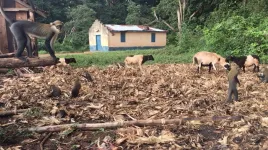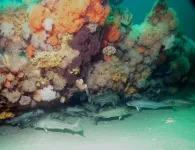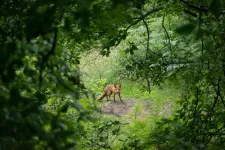(Press-News.org) NEW YORK, APRIL 5, 2021 -- Nine of the hottest years in human history have occurred in the last decade. Without a major shift in this climate trajectory, the future of life on Earth is in question. Should humans, whose fossil-fueled society is driving climate change, use technology to put the brakes on global warming?
Every month since September 2019 the Climate Intervention Biology Working Group, a team of internationally recognized experts in climate science and ecology, has gathered remotely to bring science to bear on that question and the consequences of geoengineering a cooler Earth by reflecting a portion of the sun's radiation away from the planet -- a climate intervention strategy known as solar radiation modification (SRM).
The group's seminal paper, "Potential ecological impacts of climate intervention by reflecting sunlight to cool Earth," was published in the most recent Proceedings of the National Academy of Sciences of the United States (PNAS).
"Participating in this working group has been quite eye-opening for me," said co-author Peter Groffman, an ecosystem ecologist at the Advanced Science Research Center at The Graduate Center, CUNY and the Cary Institute of Ecosystem Studies. "I was unaware that modeling climate intervention was so advanced, and I think that climate modelers were unaware of the complexities of the ecological systems being affected. It is a strong reminder of the importance of the need for multi-disciplinary analysis of complex problems in environmental science."
The interdisciplinary team is co-led by Phoebe Zarnetske, community ecologist and associate professor in Michigan State University's Department of Integrative Biology and the Ecology, Evolution, and Behavior program, and ecologist Jessica Gurevitch, distinguished professor in the Department of Ecology and Evolution at Stony Brook University.
Conversations between Gurevitch and climate scientist Alan Robock, distinguished professor in the Department of Environmental Sciences at Rutgers University, gave rise to the pioneering group, which is more aware than most that geoengineering Earth's atmosphere is more than just a science-fiction scenario.
"There is a dearth of knowledge about the effects of climate intervention on ecology," said Zarnetske. "As scientists, we need to understand and predict the positive and negative effects it could have on the natural world, identify key knowledge gaps, and begin to predict what impacts it may have on terrestrial, marine, and freshwater species and ecosystems if it were adopted in the future."
The costs and technology needed to reflect the Sun's heat back into space are currently more attainable than other climate intervention ideas like absorbing carbon dioxide (CO2) from the air. The working group anticipates their lively discussions and open access paper will encourage an explosion of scientific investigation into how a climate intervention strategy known as solar radiation modification (SRM), in tandem with greenhouse gas emissions reduction, would affect the natural world.
The feasibility of planetary-wide SRM efforts hinge on accurate predictions of its myriad outcomes provided by the well-established computer simulations of the Geoengineering Model Intercomparison Project (GeoMIP). The PNAS paper lays the foundation for expanding GeoMIP's scope to include the incredible range and diversity of Earth's ecosystems.
"While climate models have become quite advanced in predicting climate outcomes of various geoengineering scenarios, we have very little understanding of what the possible risks of these scenarios might be for species and natural systems," Gurevitch explained. "Are the risks for extinction, species community change, and the need for organisms to migrate to survive under SRM greater than those of climate change, or does SRM reduce the risks caused by climate change?"
"Most of the GeoMIP models only simulate abiotic variables, but what about all of the living things that are affected by climate and rely on energy from the sun?" Zarnetske added. "We need to better understand the possible impacts of SRM on everything from soil microorganisms to monarch butterfly migrations to marine systems."
Zarnetske's Spatial and Community Ecology Lab (SpaCE Lab) specializes in predicting how ecological communities respond to climate change across scales from the microcosm to the global, making it uniquely poised to assist the working group in illuminating vital data for future SRM scenarios such as stratospheric aerosol intervention (SAI), the focus of the paper.
SAI would reduce some of the Sun's incoming radiation by reflecting sunlight back into space, similar to what happens after large volcanic eruptions. Theoretically, it would be possible to continuously replenish the cloud and control its thickness and location to achieve a desired target temperature.
But the paper reveals the under-researched complexity of cascading relationships between ecosystem function and climate under different SAI scenarios. In fact, they argue, climate change mitigation must continue regardless of whether SRM is adopted, and the question remains whether some or any SRM can be beneficial in addition to decarbonization efforts.
"Although SAI may cool Earth's surface to a global temperature target, the cooling may be unevenly distributed, affecting many ecosystem functions and biodiversity," Zarnetske said. "Rainfall and surface ultraviolet radiation would change, and SAI would increase acid rain and would not mitigate ocean acidification."
In other words, SRM is not a magic bullet for solving climate change. Until the working group's efforts inspire new research into the effects of different climate intervention scenarios, SRM is more akin to a shot in the dark.
"We hope that this paper will spark a lot more attention to this issue and greater cooperation between scientists in the fields of climate science and ecology," added Gurevitch.
INFORMATION:
The Climate Intervention Biology working group is funded by the National Science Foundation and will host sessions at two upcoming scientific conferences: "Biosphere Responses to Geoengineering" at The American Association for the Advancement of Science (AAAS) Annual Meeting this month, and at The Ecological Society of America in August, 2021.
SARS-CoV-2 showed the world with devastating clarity the threat undetected viruses can pose to global public health. SpillOver, a new web application developed by scientists at the University of California, Davis, and contributed to by experts from all over the world, ranks the risk of wildlife-to-human spillover for newly-discovered viruses.
SpillOver is the first open-source risk assessment tool that evaluates wildlife viruses to estimate their zoonotic spillover and pandemic potential. It effectively creates a watchlist of newly-discovered viruses to help policymakers and health scientists prioritize them for further characterization, surveillance, and risk-reducing interventions.
The tool is linked to a study published in the journal PNAS, in which ...
New Haven, Conn. -- In a new study, Yale Cancer Center researchers have defined the genetic landscape of uterine leiomyosarcomas (uLMS). Furthermore, using fully sequenced patient-derived xenografts, the team has preclinically validated new treatment modalities, which may point to new treatments for uterine cancer. Study results were published online in an early edition of the Proceedings of the National Academy of Science (PNAS).
Uterine cancer is the most common gynecologic malignancy and uterine leiomyosarcomas (uLMS) are highly lethal sarcomas arising from the myometrium, the smooth muscle layer of the uterus. They represent ...
Overfishing likely did not cause the Atlantic cod, an iconic species, to evolve genetically and mature earlier, according to a study led by Rutgers University and the University of Oslo - the first of its kind - with major implications for ocean conservation.
"Evolution has been used in part as an excuse for why cod and other species have not recovered from overfishing," said first author END ...
BOSTON - Men and women whose mothers experienced stressful events during pregnancy regulate stress differently in the brain 45 years later, results of a long-term study demonstrate.
In a unique sample of 40 men and 40 women followed from the womb into their mid-forties, the brain imaging study showed that exposure during fetal development to inflammation-promoting natural substances called cytokines, produced by mothers under negative stress, results in sex-associated differences in how the adult brain responds to negative stressful situations more than 45 years after ...
High levels of biodiversity in aquatic settings offers a wide range of vitamins, minerals, and fatty acids crucial for human health, a range of nutrients that are lacking in ecosystems where the number of species have been reduced by overfishing, pollution, or climate change, researchers report April 5 in the journal Proceedings of the National Academy of Sciences.
"What we found is that biodiversity is crucial to human health," said Yale's Joey Bernhardt, a G. Evelyn Hutchinson Postdoctoral Fellow in the Department of Ecology and Evolutionary Biology and co-author of the paper.
While humans can achieve their protein requirements even with seafood from less-diverse systems, ...
A growing body of evidence suggests that biodiversity loss increases our exposure to both new and established zoonotic pathogens. Restoring and protecting nature is essential to preventing future pandemics. So reports a new Proceedings of the National Academy of Sciences (PNAS) paper that synthesizes current understanding about how biodiversity affects human health and provides recommendations for future research to guide management.
Lead author Felicia Keesing is a professor at Bard College and a Visiting Scientist at Cary Institute of Ecosystem Studies. She explains, "There's a persistent myth ...
EAST LANSING, Mich. - Nine of the hottest years in human history have occurred in the past decade. Without a major shift in this climate trajectory, the future of life on Earth is in question, which poses a new question: Should humans, whose fossil fueled society is driving climate change, use technology to put the brakes on global warming?
Michigan State University community ecologist Phoebe Zarnetske is co-lead of the Climate Intervention Biology Working Group, a team of internationally recognized experts in climate science and ecology that is bringing science to bear on the question and consequences of geoengineering a cooler Earth.
The group's ...
BOSTON - Addiction is associated with social exclusion, loss of access to resources, and general disengagement from civic life. Now, a study recently published in the journal Psychology of Addictive Behaviors and led by David Eddie, PhD, of the Massachusetts General Hospital's Recovery Research Institute has found that the majority of Americans who have resolved an alcohol or other drug problem report achievements related to self-improvement, family engagement, and civic and economic participation since resolving their addiction. Additionally, it appears these achievements accumulate with time in addiction recovery.
Incorporating data from the Recovery Research Institute's landmark 2017 National Recovery Study, which indicated ...
A new study by Stanford University biologists finds an explanation for the idea that physical characteristics such as skin pigmentation are "only skin deep." Using genetic modeling, the team has found that when two populations with distinct traits combine over generations, traits of individuals within the resulting "admixed" population come to reveal very little about individuals' ancestry. Their findings were published March 27 in a special edition of the American Journal of Physical Anthropology on race and racism.
"When two founding groups first come together, a visible physical trait that differed between those founders initially carries information about the genetic ancestry of admixed individuals," says Jaehee Kim, a postdoctoral research fellow in biology at Stanford and first author ...
In the fight against cancers, activating mutations in the RAS family of genes stand in the way of finding viable treatment options. Now, scientists at the University of Missouri and Yale University have discovered that one of these mutations -- oncogenic RAS or RASV12 -- is also responsible for the regrowth of cancer cells following genotoxic therapy treatment, or drugs that cause damage to a cancer cell's DNA in order to eliminate it from the body.
"Most of our knowledge of how cells respond to DNA damage is mainly derived from studies looking at the single cell level," said Yves Chabu, an assistant professor in the MU College of Arts and Science. "Therefore, we don't know much about how tumor cells respond to DNA damage in the broader ...



